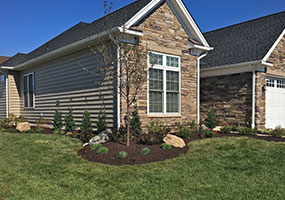Pools With Pizazz
On a hot summer day, nothing is more inviting than a swimming pool in your own backyard and the ability to take a refreshing dip with family, friends, or even by yourself.

While the practical benefits of having a pool are pretty obvious, there are several modifications that can be made, which can take a pool to the next level. An adjacent spa allows for options when it comes to water temperature. An adjoining spa where water flows from the smaller spa to the larger pool adds a unique sense of motion.
Other features can introduce a natural feel to your pool. Rocks can be used to connect your existing landscaping to the pool. One of the more dramatic additions you can add is a waterfall cascading over a series of boulders into your pool.
If you prefer a more elegant design over a natural theme, there are several options to explore. Sharp detail and fountain effects can be used to turn your pool into a moving, flowing work of art. A direct, sheer descent is one such feature that creates a continuously flowing sheet (or sheets) of water that empties into your pool from an elevated water source.
Your pool can be much more than a concrete hole filled with water that is used to cool off. It is the most prominent feature of your landscape, so let us help you make the most of it!
Planning Some Planting?
The warm days of spring and the beautiful plants you see at the garden center often lead to rushing into a landscape project – whether a single shrub or several new trees.

There’s more to proper planning and planting, but these two basics will help a lot.
• Pick the spot well. It’s so easy to overlook how big a plant is going to become when you bring it home from the nursery. The danger: Planting too close to a building, driveway, or other plants. The plant may quickly outgrow the space and then must either be pruned heavily to stay in place or removed. Solution: Know how wide the mature plant will be and allow at least half that distance from any plant, building or visual obstruction.
• Make a “big” hole. Once the plants are home, don’t dig a hole “just” big enough and stick them in. The danger: The plants will not be able to put roots into hard soil next to their rootball and they’ll be very slow in establishing. Solution: Make the hole at least twice the size as the ball, loosen the soil well, and add some organic material.




